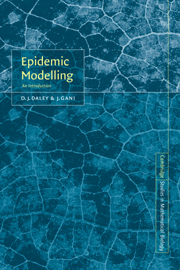4 - Stochastic Models in Discrete Time
Published online by Cambridge University Press: 16 November 2009
Summary
To describe the spread of a disease whose infectious period is relatively short in comparison with the latent period, especially in smaller populations, it is convenient to use a discrete-time model with the latent period as the unit of time. There are two such ‘classical’ models, one tracing back to Reed and Frost in 1928 (Abbey, 1952) and the other to Greenwood (1931). Both entail sequences of random variables with binomial distributions, hence the term ‘chain binomials’. The fact that they are Markov chains was not fully appreciated until the work of Gani and Jerwood (1971).
It should be apparent that in this setting it makes little sense to model a simple epidemic as we did at the start of Chapters 2 and 3; here the ‘short’ infectious period allows us to identify a class of ‘former infectives’ that are in fact removed. Any individual that becomes an infective, is thus infectious for exactly one unit of time. However, there can be mathematical reasons for considering such analogues, as for example in Daley and Gani (1999) (see also Section 4.6 below).
It becomes clear in this setting that there are successive generations of infectives. When the initial infectives are infectious around the same time, as is necessarily the case with a single initial infective, successive generations will not overlap in time. The success of the Kermack–McKendrick theory in modelling the spread of epidemics like measles realistically, can be attributed to the fact that there is a considerable number of smaller scale overlapping epidemics.
- Type
- Chapter
- Information
- Epidemic ModellingAn Introduction, pp. 105 - 132Publisher: Cambridge University PressPrint publication year: 1999



